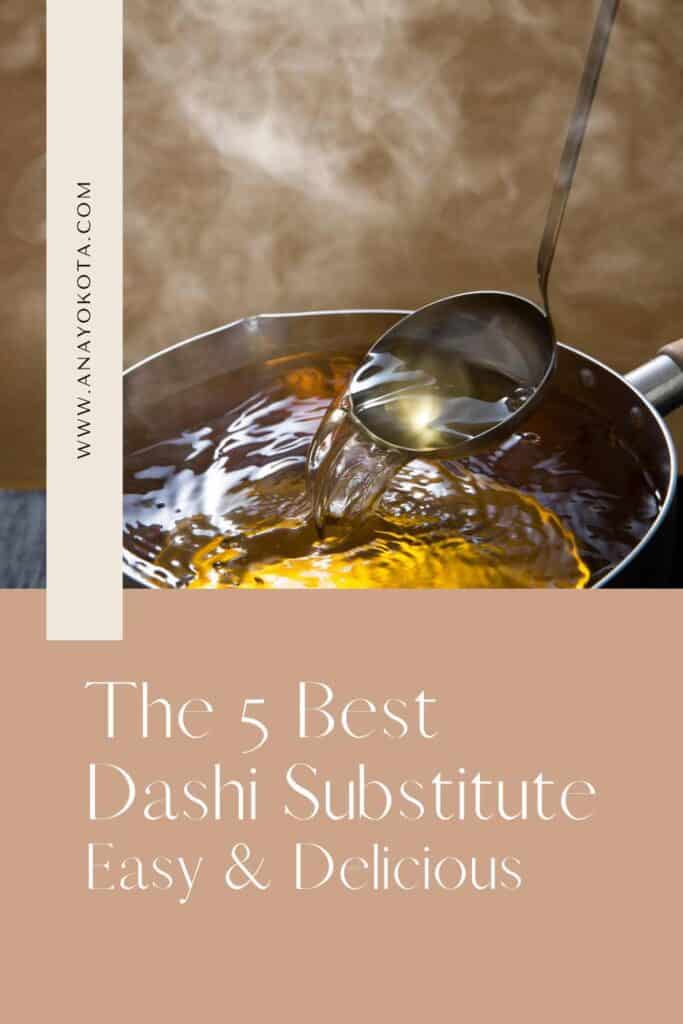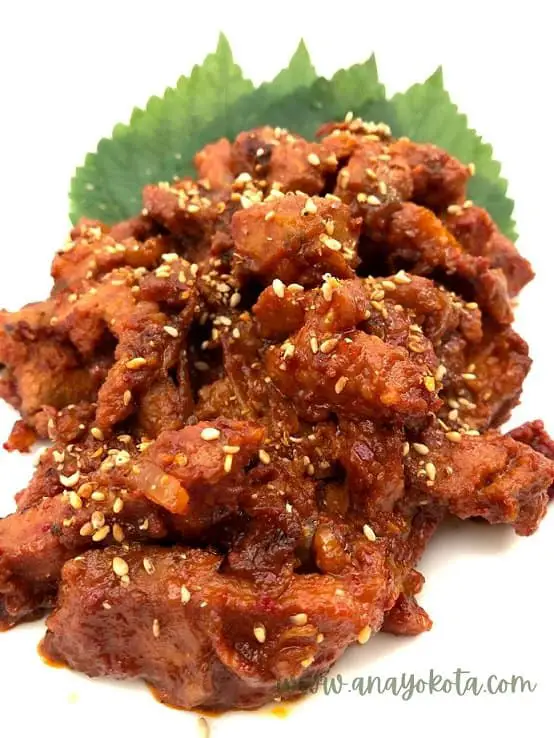This post may contain affiliate links. Please read my disclosure policy for more info.
Trying to find the best dashi substitute? Look no further! In this article, I provide dashi alternatives that can help when you are wanting to make dashi but either don’t have it or simply want to change things up.
Anyone who loves Japanese or Asian cuisine is likely familiar with dashi, the ubiquitous stock made from dried kelp and bonito flakes. However, if you’re like me and live in a part of the world where kelp is hard to come by, or if you just want to try something different, here are 5 great dashi substitutes to add flavor to your next dish. Enjoy!

WHAT DOES DASHI TASTE LIKE?
What is dashi? Dashi is a light, savory broth that forms the base of many Japanese dishes. It’s made by simmering kombu (dried kelp) and bonito flakes (dried, smoked skipjack tuna) in water to extract their umami-rich flavors. As a result, dashi has a deep, complex flavor that is simultaneously savory, sweet, and slightly fishy. Additionally, dashi contains high levels of glutamic acid, which gives it a naturally savory taste.
If you’ve ever had miso soup, sushi rice, sunomono (vinegared vegetables), or chawanmushi (savory egg custard), then you’ve already tasted dashi. Because it is such a versatile ingredient, dashi is used in a wide variety of dishes including soups, stews, sauces, marinades, and more. Not to mention, it’s incredibly easy to make at home! So, if you’re looking to add a little umami to your cooking, read on for everything you need to know about dashi.
HOW TO MAKE DASHI
There are three main types of dashi – ichiban dashi (first dashi), niban dashi (second dashi), and awase dashi (blended dashi). Ichiban dashi is made by simmering kombu in water for 30 minutes before removing the kelp and adding bonito flakes. Niban dashi is made using the leftovers from ichiban dashi – the kombu and bonito flakes that have been simmered in water. Finally, awase dashi is a blend of both ichiban and niban dashis. It is considered the highest quality type of dashi because it has the strongest flavor.
Dashi can also be made using only kombu (kombu dashi), only bonito flakes (hoshi obushi), or a combination of sardines and kelp (niboshi). While these variations don’t have the same depth of flavor as traditional ichiban or niban dashis, they are still very tasty and can be used in many different dishes.
No matter which type of dashi you decide to make, the process is mostly the same. For an easy dashi stock, simply combine the ingredients in a pot or teapot filled with cold water and allow them to steep for 30 minutes. Once steeped, strain the liquid through a cheesecloth or coffee filter to remove any solids. And that’s it – you’ve now made delicious homemade dashi!.
Alternatively, you can always purchase dashi powder, which pretty much contains everything you need to make delicious soup. Simply add water to the dashi powder and voila!
But what if you don’t have either dashi ingredients or dashi powder to make dashi stock? I’ll get to that in a minute on a great dashi powder substitute.
1. FISH STOCK

Dashi is a Japanese soup stock typically made from kelp and bonito fish flakes. However, dashi can be difficult to find outside of Japan, and it can also be pricey. Luckily, there is a simple substitution that can be used to create a delicious dashi-flavored broth: fish stock.
Fish stock can be easily purchased at most supermarkets, and it provides a rich umami flavor that is perfect for simmered dishes and soups. Sometimes, I’ll add a little fish sauce to make a dashi substitute fish sauce. However, not every market has fish stock. You can always make your own fish stock by adding a fish (with bone) of your choice and simmering. Allow me to explain the process:
To use fish stock as a dashi substitute, first simmer a pot of water and add a few pieces of dried or fresh fish (with an optional piece of kelp for umami) for 10 minutes before removing the fish (and kelp). Then I add a few dashes of fish sauce to add flavor and you’re done. It’s not necessary to use fish sauce, but I like adding just a few drops to elevate the salty flavor. With this easy substitution, you can enjoy the flavor of dashi without having to seek out special ingredients.
2. MUSHROOM AND SEAWEED

Mushrooms and seaweed can be used to create a Dashi-like broth and a great substitute for kombu. This is a wonderful substitute for dashi because both ingredients can be found easily at most supermarkets.
To do this dashi replacement, simply simmer the mushrooms and seaweed in water for about 30 minutes. I prefer dried shiitake mushrooms because they add more mushroom-like flavor. You can add as much or as little of each ingredient as you desire. The more shiitake mushrooms and seaweed (such as kombu) you put, the stronger the substitute dashi will be.
If you would like to add a little sodium, the best way to do that is to add soy sauce rather than salt. Although you certainly can add whatever salty flavor you like, the depth of dried shiitake and soy sauce is so delicious. The resulting broth will have a similar flavor to a vegetarian dashi, making it perfect for use in vegetable soups and other dishes.
3. SHELLFISH

Since dashi has a fish forward flavor, it makes sense that another seafood option could be used as a dashi stock replacement. Shellfish, such as shrimp or lobster, can be simmered in water to create a substitute dashi.
Simply simmer the shellfish in water for 10-20 minutes (depending on how strong you want the shellfish flavor, then remove the shells and use the broth as desired. If you would like to add a salty flavor, you can use soy sauce or fish sauce. But be careful because a little goes a long way.
4. ANCHOVY

Anchovies can be a great dashi broth substitute because it’s easy to find and it has a strong flavor. Anchovy is my favorite and easiest way to create amazing dashi stock substitute. As a matter of fact, many Korean cooks will use anchovies in their dashi stock powder.
To use anchovies as a dashi substitute, simply simmer a few anchovies in water for 10 minutes. Then, remove the anchovies and use the broth as desired. Sometimes, I’ll choose to use anchovies over a fish or kombu dashi powder in my kimchi jjigae because it provides a cleaner soup flavor.
5. DRIED BONITO FLAKES

If you can’t find any of the above ingredients, or if you want to create a dashi substitute for miso soup from scratch, then you can always use dried bonito flakes. Dried bonito shavings are made from a type of fish called bonito, and they have a strong flavor that is perfect for making Dashi. I love using bonito flakes as my miso soup base instead of only adding miso paste because it elevates the depth of umami in the soup.
To use dried bonito flakes as a dashi substitute, simply simmer the flakes in water for a few minutes (just until it’s melted) and use the broth as desired. You can also use bonito powder if you can’t find the flakes.
WHAT NOT TO USE
Just because dashi is used for stock doesn’t mean you can just use any kind of stock.
Remember, dashi is more of a fish base, which means to keep the ingredients from the ocean if you’re trying to substitute dashi. Don’t use chicken stock powder, chicken stock, beef broth, turkey broth, or anything that’s pretty much not from the sea. I wouldn’t recommend regular vegetable stock either unless it had ingredients from the sea, such as: kelp, kombu, or other types of seaweed.
USES FOR DASHI
As we mentioned before, because it is so versatile, there are endless uses for dashi in cooking. Here are just a few ideas:
– Use it as a base for soups like miso soup or shabu shabu soup.
– Use it to season cooked vegetables like eggplant or mushrooms.
– Use it as a marinade for grilled meats or fish.
– Use it to make dipping sauces for tempura or sushi.
– Use it to spice up plain rice or noodles.
– Use it as an alternative to chicken broth when making soup or stew.
If you’re looking for recipes where I make stock from vegetable skins, try my Gamjatang recipe where I make a hearty Korean soup from scratch.
No matter how you use it, homemade dashi is sure to elevate your cooking and add some extra umami flavor to your favorite dishes. Now let’s dive a little deeper on the top 5 dashi stock recipes.
CONCLUSION

The 5 best Dashi substitutes are: fish stock, mushroom and seaweed, shellfish, anchovy, and dried bonito flakes. Each of these ingredients can be used to create a broth that has a similar flavor to Dashi because they all have something in common – ingredients from the sea.
With these five Dashi substitutes, you can easily add flavor to your favorite dishes without having to seek out special ingredients. So go ahead and experiment with different flavors, and enjoy the delicious results!













